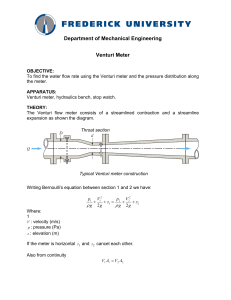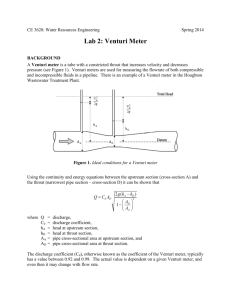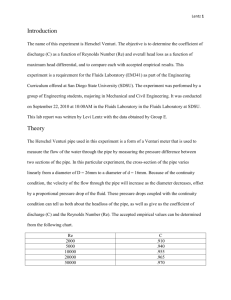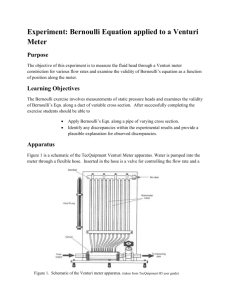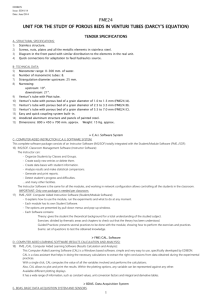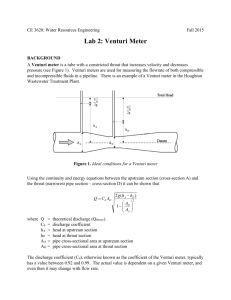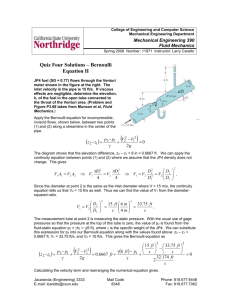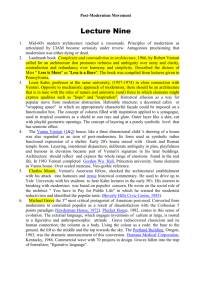Exp 1
advertisement
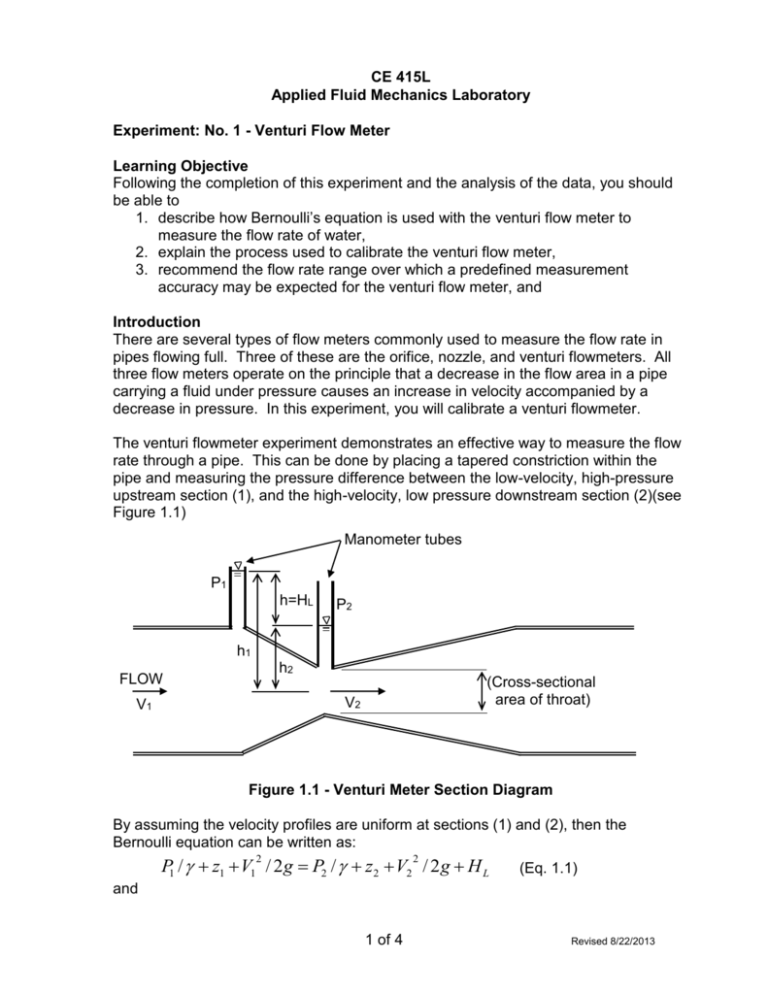
CE 415L Applied Fluid Mechanics Laboratory Experiment: No. 1 - Venturi Flow Meter Learning Objective Following the completion of this experiment and the analysis of the data, you should be able to 1. describe how Bernoulli’s equation is used with the venturi flow meter to measure the flow rate of water, 2. explain the process used to calibrate the venturi flow meter, 3. recommend the flow rate range over which a predefined measurement accuracy may be expected for the venturi flow meter, and Introduction There are several types of flow meters commonly used to measure the flow rate in pipes flowing full. Three of these are the orifice, nozzle, and venturi flowmeters. All three flow meters operate on the principle that a decrease in the flow area in a pipe carrying a fluid under pressure causes an increase in velocity accompanied by a decrease in pressure. In this experiment, you will calibrate a venturi flowmeter. The venturi flowmeter experiment demonstrates an effective way to measure the flow rate through a pipe. This can be done by placing a tapered constriction within the pipe and measuring the pressure difference between the low-velocity, high-pressure upstream section (1), and the high-velocity, low pressure downstream section (2)(see Figure 1.1) Manometer tubes P1 h=HL P2 h1 h2 FLOW (Cross-sectional area of throat) V2 V1 Figure 1.1 - Venturi Meter Section Diagram By assuming the velocity profiles are uniform at sections (1) and (2), then the Bernoulli equation can be written as: P1 / z1 V1 / 2 g P2 / z2 V2 / 2 g H L 2 2 (Eq. 1.1) and 1 of 4 Revised 8/22/2013 Experiment: No. 1 - Venturi Flow Meter CE 415L Q A1 *V1 A2 *V2 (Eq. 1.2) P1 , V1 and z1 refer to the head pressure, velocity and elevation, respectively, of the flow upstream of the constriction (section 1). P2 , V2 and z2 refer to the head pressure, velocity and elevation, respectively, of the flow at or immediately downstream of the constriction (section 2). HL is the headloss from area (1) to (2) that accounts for energy losses associated with the flow constriction. Note that the unit weight of water, = ρg, where ρ is the density of water and g is the acceleration due to gravity. The ideal situation has HL=0, i.e., no headloss, meaning no energy in the fluid stream is lost. The difficulty in including the headloss is that there is no accurate expression to account for it. The result is that empirical coefficients are used in the flow rate equations to account for the headloss. The equation typically used for a venturi flow meter is: Q KA 2 gh (Eq. 1.3) Where Q = Flowrate (ft3/s) A = Venturi throat cross-sectional area (ft2) g = Acceleration due to gravity (32.2 ft/s2) h = Pressure head difference due to the venturi (ft of water) K = Venturi flow coefficient (dimensionless) Note that h is not the total energy headloss, just the pressure head difference due to the change in pressure head across the venturi section. Effects of the venturi flow meter on the system energy grade line (EGL) and hydraulic grade line (HGL) are illustrated in Figure 1.2. 1 2 EGL h HGL v2/2g FLOW Figure 1.2 - Venturi Flow Meter Energy Effects in a System 2 of 4 Revised 8/22/2013 Experiment: No. 1 - Venturi Flow Meter CE 415L Purpose The purpose of this experiment is to determine the value of K and compare it to the values documented in literature. (Note the value of K is a function of =d/D and the Reynolds Number, Re=VD/) Equipment o Hampden Model H-6925 Fluid Circuits Demonstrator (with venturi flow meter section installed, inlet diameter = 1.049 inch, throat diameter = 0.750 inch) o Differential manometer. Procedure To reduce stresses on the pump, the main flow control valve, Globe Valve should be closed (or nearly so) before turning the pump either on or off. 1. Close all the valves on the demonstrator. 2. Attach the plastic tubes from the manometer to the pressure taps next to the venturi throat. This will measure the head difference before and after the venturi throat, or (h = h1 – h2). Bleed the air trapped in the lines to the manometer. Adjust the water levels in the manometer tubes to within 0.1 inch of each other. 3. Open valves 6, 7, 8, 9,13 and the Gate Valve (in the horizontal 1-inch pipe). Turn the pump power ON and then open the Globe Valve. 4. Adjust the Globe Valve to obtain a flowrate of 2 gallons per minute (gpm) as indicated by the Omega flowmeter (observed flow rate.) 5. Record the measured flowrate along with the differential headloss in the data table below. Take the representative (average) pressure reading at the current flowrate and enter in the data table. NOTE: Be sure to re-zero (tare) the digital manometer just before each reading. Note that because of the averaging algorithm the manometer display uses it may take several (typically about 5) seconds before it settles to the actual value. 6. Repeat the pressure measurements for a total of six (6) flowrate settings by adjusting the Globe Valve for additional flow rates of approximately 4, 8, 12 16 and 20 gpm (or the highest flowrate that can be achieved up to the flowmeter capacity). 3 of 4 Revised 8/22/2013 Experiment: No. 1 - Venturi Flow Meter CE 415L Table 1.1 - Experimental data. Trial Qobs (gpm) h (inch of H2O) 1 2 3 4 5 6 Note: 1 gpm = 0.002228 ft3/s Analysis 1. Determine the venturi flow coefficient K from the equation Qobs KA 2 gh by linear regression (i.e. trendline). In this equation Qobs is the observed flow rate for each trial. Plot Qobs (y-axis) vs. A 2 gh (x-axis). The slope of that line is the value of K. 2. Compare the computed K to the typical value listed in a suitable reference. 3. Take the K value and insert it into the formula KA 2 gh to find Qcalc . Enter these numbers in a table like shown in Table 1.2 below. 4. Plot Qobs vs. Qcalc data points and a linear trendline to see how well the observed results compare with the results using your computed K value. The slope of this line should be close to one. Also, display the R 2 for the linear trendline. 5. What could you do to Eq. 1.3 to improve the match between your experimental results and the results calculated by Eq. 1.3? Write the improved equation and demonstrate the improved accuracy of the resulting equation compared to the flow rate indicated by the Omega flow meter. Table 1.2 – Suggested data table header Trial h (inch H2O) h (ft H2O) Qobs (gpm) Qobs (ft3/sec) A*(2gh)^0.5 (ft3/sec) K Qcalc=KA*(2gh)^0.5 (ft3/sec) Report Please refer to the report requirements included in the syllabus and posted on the course website. 4 of 4 Revised 8/22/2013

